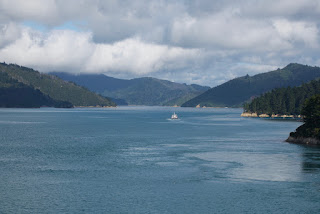 |
| Fiordland National Park, New Zealand |
We didn't realize how lucky we have been with the weather here. Most mornings we have awakened to misty rain, but the clouds have mostly dissipated by late morning, breaking into sunshine. During our last WhatsApp call, Liz and Walter, our Aussie friends, told us that New Zealand is known as the "land of the long grey cloud." A lady working at the Fiordland National Park told us it rains an average of 263 days a year here.
Now we have spent three days in rain... solid days of rain.. windshield wipers going full time rain. The rain makes it more difficult to do anything and everything. Negotiating towns is more difficult. Camping in this tiny camper is more difficult. Maintaining our sunny dispositions is more difficult.
We finally reached our first national park on the South Island and were delighted. After all this farmland and pastures, sheep and cows, we had been searching for remoteness and knew we would be finally able to enjoy here. We were wrong. We must have traveled behind a dozen tour buses, all heading to Milford Sound, the end of the national park road. And still the rain continued until the rivers began to overflow. Every divot in the mountains surrounding us became a waterfall, all leading to the rivers.
 |
| Every divot became a waterfall |
We tried stopping at one of the tracks (New Zealand for hikes), but it was raining too hard to even attempt the trail. We did, however, find a Kea, a rare mountain parrot, living in the parking lot, mooching food. Only 5,000 of these birds remain. The rain was pouring so hard and the light so low, the photo is blurry.
 |
| Kea in Fiordland National Park |
I wish I could explain how treacherous the streams and creeks and rivers became. The visitor center folks had warned us of flooding issues in some of the campgrounds. As the deluge of rain continued, we decided to camp in town to stay as far as possible from flooding. If you can view this short video, you may be able to get a feel for one of the park's raging rivers.
We drove out of Te Anua the next morning, hoping for sunshine further down the road. We found none. We had met several folks who told us that Queenstown, a ski resort, was a must see. In Liz's words, it was a fizzer. We drove into the city... and as quickly as we could drove out. It was crowded, with cramped roads, too many tourists, and too little space. We continued, traveling into the mountains.
We laughed and told ourselves that the scenery would have been spectacular in the sun. Instead, we drove mountain roads in hard rain and low clouds. Even creeks that we crossed had turned treacherous.
We finally found a spot to camp. It was secluded and lovely. Just the kind of thing we had been hoping to find since we arrived. Although the rain continued, it was a special place, and it felt wonderful.
By morning, the rain had stopped. It felt glorious to see the sun peeking through the clouds. We even found a rainbow... certainly a good omen.
 |
| Rainbow over Lake Wanaka, New Zealand |
Less than a half hour into our continued journey to the west coast, however, we found the road closed, with barriers across it. So close and yet so far away. We turned around and found a nearby shop. The caretaker told us that the heavy rain had washed out a bridge, and the road was closed indefinitely.
Time for Plan B. We followed our route back... and the advancing rainbow. My great navigator found a way to zig-zag back across to the east coast of the island then reach the west coast via another route.
That is what we have done today. Because we couldn't find the free camping site, we are in the town of Geraldine, hooked up to electricity and WiFi at the local holiday park, taking showers, and preparing for another run at the West Coast tomorrow. News reports say this is one of the worst rains they have had on the West Coast in years.
For us, it has been a day of sunshine and beautiful mountain vistas. We passed a turquoise, glacial-fed lake we never would have seen without the rainstorm. Life is, indeed, good.
 |
| Lake Tekapo, New Zealand |
Please forgive the poor resolution on these photos... WiFi is very slow here, so it is the only way I can upload photos.





















































